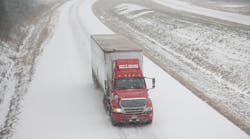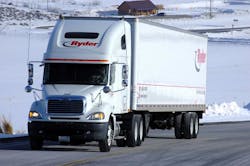Winter is around the corner. Colder temperatures often mean an uptick in idle time, lower tire pressure, and heavier rolling resistance – all leading to deteriorated fuel economy.
But Mike Spence, senior vice president of fleet service at Fleet Advantage, said fleets can combat some of these winter woes with last year’s data. He suggests fleet managers start reviewing their fleet’s data from the past 13 months to make the appropriate moves before winter begins.
“Past fuel economy is a good indicator of what future fuel economy will be unless you make significant changes,” Spence explained. “Determine if that’s where you want to be or whether you want to improve that.”
Past data also serves as a good indicator of driving habits, Spence said. Data history can indicate hard braking, sudden full stops, full throttle starts, and other safety-related driving behaviors. Spence suggests fleet managers take that data and implement a training session on what drivers did last year compared to what fleets expect this year.
He also noted fleets should keep an eye on idle time. Truck idle time peaks in the summer and peaks again in the winter, he explained, noting idle can increase around 40-45% in the winter – up from 20-25% regularly.
“You need every break in the winter when you’re in the trucking business without any downtime or breakdowns and winter problems,” Spence said. “Using data to differentiate your fleet from other fleets is a good place to start. But really it’s all about how you can tailor a training plan based on the data to get the drivers to improve safety and fuel economy at same time.”
Spence also noted that it is important to keep tires at optimal air pressure as soon as temperatures drop. He also mentioned that batteries have less capacity strength and power during the winter.
“You can look at the past and determine where you were in the past from an mpg standpoint and created change and set new points in the data that can help you overcome what happens in the winter anyway,” he added. “Data can help you get on top of some of the operating issues and help you improve the mpg.”
A. Duie Pyle is one fleet that has begun its winter prep by expanding its Protect From Freeze (PFF) service for the 2016/2017 winter season. During the year Pyle said it added 40 new heated and insulated trailers to its fleet.
Pyle’s PFF service consists of heated service centers and heated/insulated trailers for line haul, pick up, and delivery operations providing 24/7 protection. Pyle said each of its service centers has onsite, company-owned snow removal equipment and independent emergency power sources to protect customers’ shipments and assure continuous operations during severe weather events.
“Many carriers opt to implement moratoriums during cold snaps and over weekends, causing uncertainties and delays for customers,” Randy Swart, COO of A. Duie Pyle, said. “Pyle’s Protect From Freezing service is unique. We have worked hard to make sure our service is available to all of our customers without interruption, regardless of temperature or day of the week.”
Ryder is also preparing for winter and offering advice through its Winter Preparedness Hub. Ryder compiled tip sheets on winter truck maintenance, tire essentials, fueling, engine technology, and driver fatigue – all available for download.
Here are some tips from Ryder:
- When temperatures drop below 20, add a diesel fuel anti-gel additive to the fuel tank.
- Use quality winter blend fuel in your tank.
- Keep fuel tank half full. Condensation can build up in a near-empty gas tank in extremely cold temperatures. This can cause fuel line freeze-up and no-start conditions.
- Plan ahead: Think in terms of geographically where the coldest point is that the vehicle will travel to.
- Keep a vehicle running at highway speeds in extreme temperatures vs. idling so it can reach the temperature threshold required for the regeneration and Diesel Engine Fluid cycling processes.
- Avoid cold soaks. Cold soaks occur when the engine fluids and the steel of the engine block drop to low ambient temperatures, Ryder explained. This happens when a vehicle sits for more than a day and it impacts starting and charging systems.
- Check tires often. Correctly inflated tires in good condition will help prevent breakdowns and accidents.
- Daily pre-trips: Drivers should include inspecting their vehicle for frozen components like trailer doors, power cords, etc.
According to Ryder, battling driver fatigue is another problem fleets should tackle this winter. “Driver fatigue is a serious safety issue, particularly in the winter,” the company said. “Driver fatigue isn’t just about falling asleep – it’s about tiredness, weariness, or exhaustion. Fatigue slows reflexes and affects a driver’s ability to concentrate and respond to conditions – increasing the chances of a crash that could have a significant impact on your company’s costs and productivity.”
Here are some best practices from Ryder:
- Create a culture of open and honest communication about driver fatigue.
- Plan ahead and consider the driver’s commute time when complying with HOS regulations.
- Teach drivers that it’s not better to “push through,” but to find somewhere to stop and rest.
- Encourage drivers to report fatigue – regularly ask for feedback both pre- and post-trip.
- Educate drivers on knowing the early signs of fatigue – yawning, frequent blinking, and drowsiness.
- Use lane tracking devices.
- If possible, avoid scheduling driving during the early morning/pre-dawn hours when fatigue is more prevalent.
- Remind drivers about the need to avoid medications that may cause drowsiness.





